stop start FIAT QUBO 2010 1.G User Guide
[x] Cancel search | Manufacturer: FIAT, Model Year: 2010, Model line: QUBO, Model: FIAT QUBO 2010 1.GPages: 230, PDF Size: 4.38 MB
Page 123 of 230
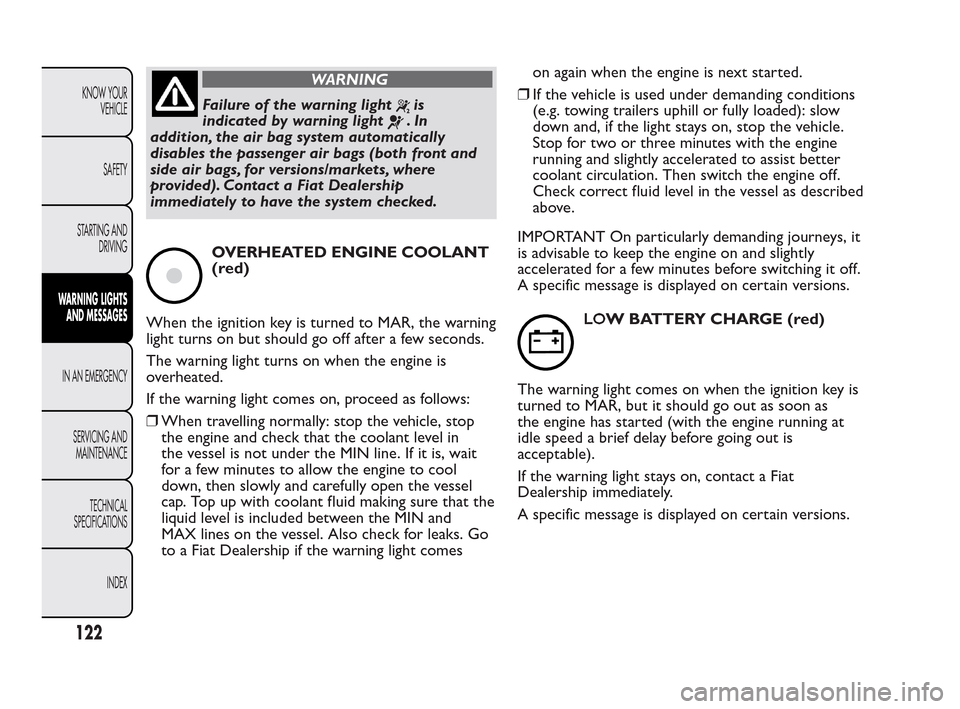
WARNING
Failure of the warning lightis
indicated by warning light
.In
addition, the air bag system automatically
disables the passenger air bags (both front and
side air bags, for versions/markets, where
provided). Contact a Fiat Dealership
immediately to have the system checked.
OVERHEATED ENGINE COOLANT
(red)
When the ignition key is turned to MAR, the warning
light turns on but should go off after a few seconds.
The warning light turns on when the engine is
overheated.
If the warning light comes on, proceed as follows:
❒When travelling normally: stop the vehicle, stop
the engine and check that the coolant level in
the vessel is not under the MIN line. If it is, wait
for a few minutes to allow the engine to cool
down, then slowly and carefully open the vessel
cap. Top up with coolant fluid making sure that the
liquid level is included between the MIN and
MAX lines on the vessel. Also check for leaks. Go
to a Fiat Dealership if the warning light comeson again when the engine is next started.
❒If the vehicle is used under demanding conditions
(e.g. towing trailers uphill or fully loaded): slow
down and, if the light stays on, stop the vehicle.
Stop for two or three minutes with the engine
running and slightly accelerated to assist better
coolant circulation. Then switch the engine off.
Check correct fluid level in the vessel as described
above.
IMPORTANT On particularly demanding journeys, it
is advisable to keep the engine on and slightly
accelerated for a few minutes before switching it off.
A specific message is displayed on certain versions.
LOW BATTERY CHARGE (red)
The warning light comes on when the ignition key is
turned to MAR, but it should go out as soon as
the engine has started (with the engine running at
idle speed a brief delay before going out is
acceptable).
If the warning light stays on, contact a Fiat
Dealership immediately.
A specific message is displayed on certain versions.
122
KNOW YOUR
VEHICLE
SAFETY
STARTING AND
DRIVING
WARNING LIGHTS
AND
MESSAGES
IN AN EMERGENCY
SERVICING
AND
MAINTENANCE
TECHNICAL
SPECIFICATIONS
INDEX
Page 125 of 230
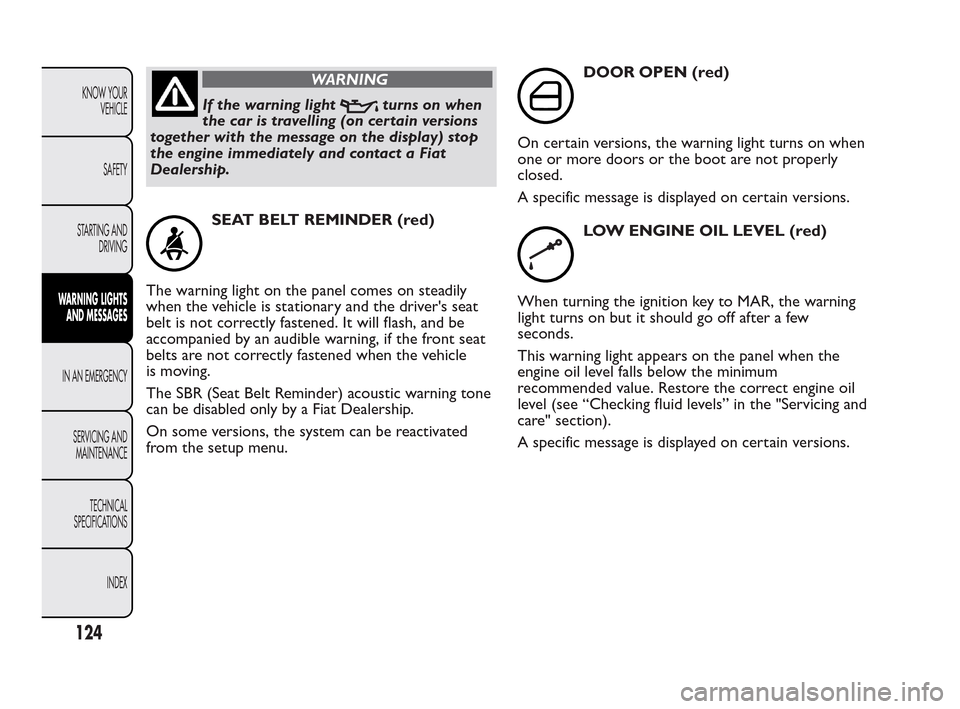
WARNING
If the warning lightturns on when
the car is travelling (on certain versions
together with the message on the display) stop
the engine immediately and contact a Fiat
Dealership.
SEAT BELT REMINDER (red)
The warning light on the panel comes on steadily
when the vehicle is stationary and the driver's seat
belt is not correctly fastened. It will flash, and be
accompanied by an audible warning, if the front seat
belts are not correctly fastened when the vehicle
is moving.
The SBR (Seat Belt Reminder) acoustic warning tone
can be disabled only by a Fiat Dealership.
On some versions, the system can be reactivated
from the setup menu.
DOOR OPEN (red)
On certain versions, the warning light turns on when
one or more doors or the boot are not properly
closed.
A specific message is displayed on certain versions.
LOW ENGINE OIL LEVEL (red)
When turning the ignition key to MAR, the warning
light turns on but it should go off after a few
seconds.
This warning light appears on the panel when the
engine oil level falls below the minimum
recommended value. Restore the correct engine oil
level (see “Checking fluid levels” in the "Servicing and
care" section).
A specific message is displayed on certain versions.
124
KNOW YOUR
VEHICLE
SAFETY
STARTING AND
DRIVING
WARNING LIGHTS
AND
MESSAGES
IN AN EMERGENCY
SERVICING
AND
MAINTENANCE
TECHNICAL
SPECIFICATIONS
INDEX
Page 134 of 230
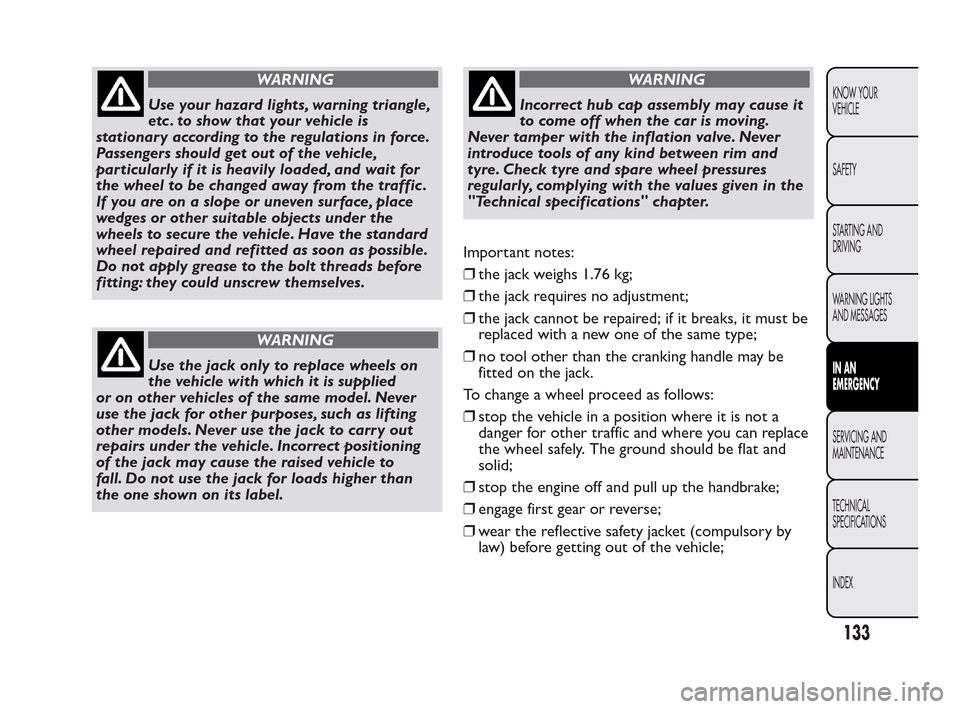
WARNING
Use your hazard lights, warning triangle,
et
c . to show that your vehicle is
stationary according to the regulations in force.
Passengers should get out of the vehicle,
particularly if it is heavily loaded, and wait for
the wheel to be changed away from the traffic .
If you are on a slope or uneven surface, place
wedges or other suitable objects under the
wheels to secure the vehicle. Have the standard
wheel repaired and refitted as soon as possible.
Do not apply grease to the bolt threads before
fitting: they could unscrew themselves.
WARNING
Use the jack only to replace wheels on
t
he vehicle with which it is supplied
or on other vehicles of the same model. Never
use the jack for other purposes, such as lifting
other models. Never use the jack to carry out
repairs under the vehicle. Incorrect positioning
of the jack may cause the raised vehicle to
fall. Do not use the jack for loads higher than
the one shown on its label.
WARNING
Incorrect hub cap assembly may cause it
to
come off when the car is moving.
Never tamper with the inflation valve. Never
introduce tools of any kind between rim and
tyre. Check tyre and spare wheel pressures
regularly, complying with the values given in the
"Technical specifications" chapter.
Important notes:
❒the jack weighs 1.76 kg;
❒the jack requires no adjustment;
❒the jack cannot be repaired; if it breaks, it must be
replaced with a new one of the same type;
❒no tool other than the cranking handle may be
fitted on the jack.
To change a wheel proceed as follows:
❒stop the vehicle in a position where it is not a
danger for other traffic and where you can replace
the wheel safely. The ground should be flat and
solid;
❒stop the engine off and pull up the handbrake;
❒engage first gear or reverse;
❒wear the reflective safety jacket (compulsory by
law) before getting out of the vehicle;
133
KNOW YOUR
VEHICLE
SAFETY
STARTING AND
DRIVING
WARNING LIGHTS
AND MESSAGES
IN AN
EMERGENCY
SERVICING AND
MAINTENANCE
TECHNICAL
SPECIFICA
TIONS
INDEX
Page 142 of 230
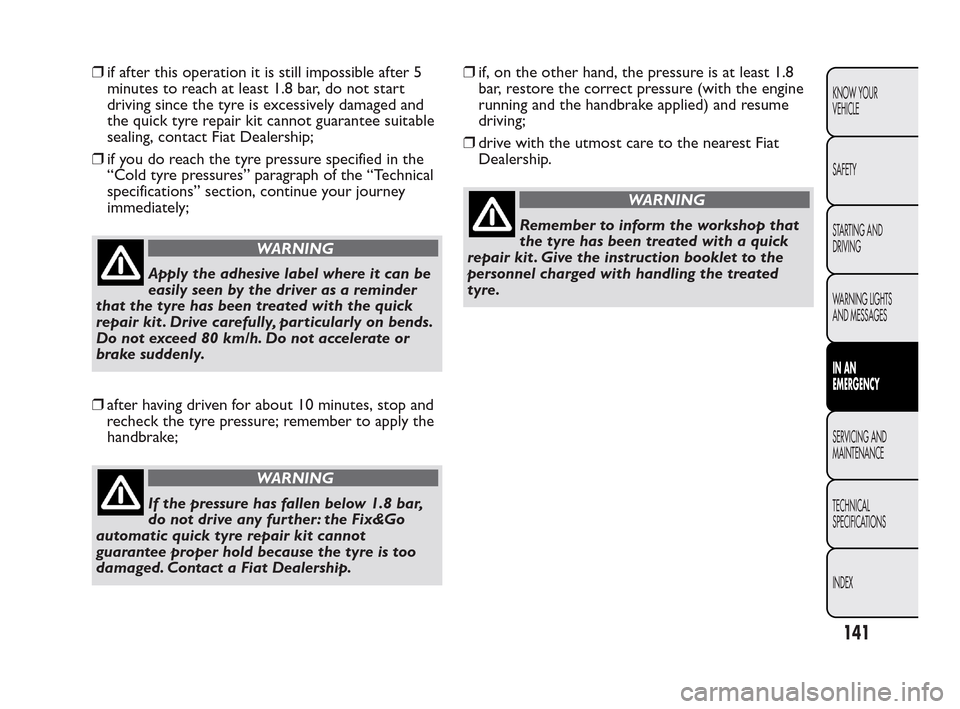
❒if after this operation it is still impossible after 5
minutes to reach at least 1.8 bar, do not start
driving since the tyre is excessively damaged and
the quick tyre repair kit cannot guarantee suitable
sealing, contact Fiat Dealership;
❒if you do reach the tyre pressure specified in the
“Cold tyre pressures” paragraph of the “Technical
specifications” section, continue your journey
immediately;
WARNING
Apply the adhesive label where it can be
easily
seen by the driver as a reminder
that the tyre has been treated with the quick
repair kit . Drive carefully, particularly on bends.
Do not exceed 80 km/h. Do not accelerate or
brake suddenly.
❒after having driven for about 10 minutes, stop and
recheck the tyre pressure; remember to apply the
handbrake;
WARNING
If the pressure has fallen below 1.8 bar,
do
not drive any further: the Fix&Go
automatic quick tyre repair kit cannot
guarantee proper hold because the tyre is too
damaged. Contact a Fiat Dealership.❒if, on the other hand, the pressure is at least 1.8
bar, restore the correct pressure (with the engine
running and the handbrake applied) and resume
driving;
❒drive with the utmost care to the nearest Fiat
Dealership.
WARNING
Remember to inform the workshop that
t
he tyre has been treated with a quick
repair kit . Give the instruction booklet to the
personnel charged with handling the treated
tyre.
141
KNOW YOUR
VEHICLE
SAFETY
STARTING AND
DRIVING
WARNING LIGHTS
AND MESSAGES
IN AN
EMERGENCY
SERVICING AND
MAINTENANCE
TECHNICAL
SPECIFICA
TIONS
INDEX
Page 162 of 230
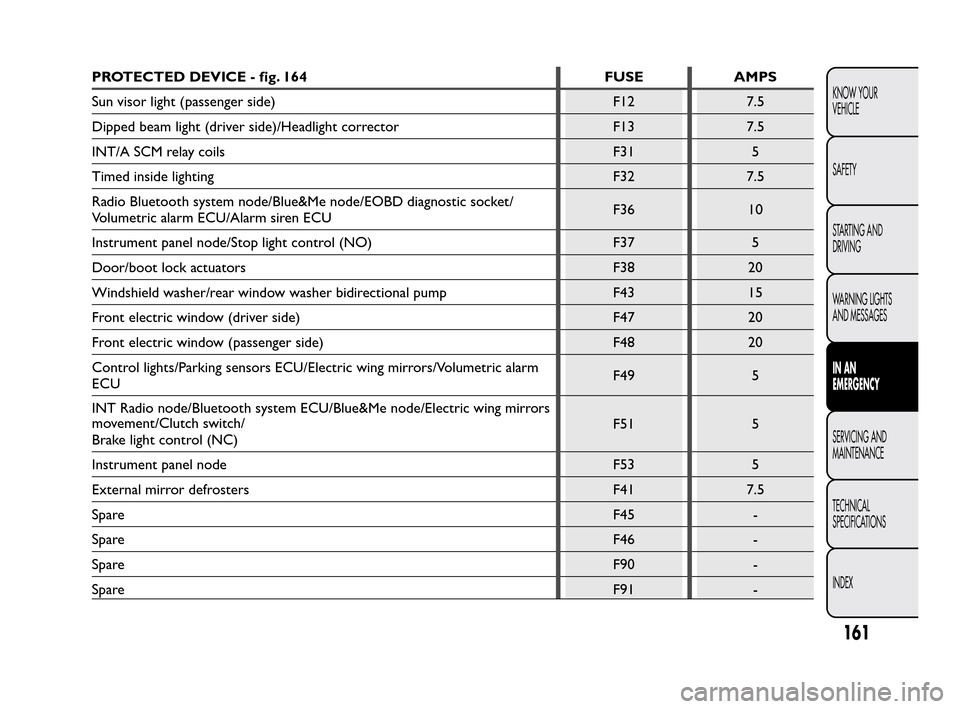
PROTECTED DEVICE - fig. 164 FUSE AMPS
Sun visor light (passenger side) F12 7.5
Dipped beam light (driver side)/Headlight corrector F13 7.5
INT/A SCM relay coils F31 5
Timed inside lighting F32 7.5
Radio Bluetooth system node/Blue&Me node/EOBD diagnostic socket/
Volumetric alarm ECU/Alarm siren ECUF36 10
Instrument panel node/Stop light control (NO) F37 5
Door/boot lock actuators F38 20
Windshield washer/rear window washer bidirectional pump F43 15
Front electric window (driver side) F47 20
Front electric window (passenger side) F48 20
Control lights/Parking sensors ECU/Electric wing mirrors/Volumetric alarm
ECUF49 5
INT Radio node/Bluetooth system ECU/Blue&Me node/Electric wing mirrors
movement/Clutch switch/
Brake light control (NC)F51 5
Instrument panel node F53 5
External mirror defrosters F41 7.5
SpareF45 -
SpareF46 -
SpareF90 -
SpareF91 -
161
KNOW YOUR
VEHICLE
SAFETY
STARTING AND
DRIVING
WARNING LIGHTS
AND MESSAGES
IN AN
EMERGENCY
SERVICING AND
MAINTENANCE
TECHNICAL
SPECIFICA
TIONS
INDEX
Page 166 of 230
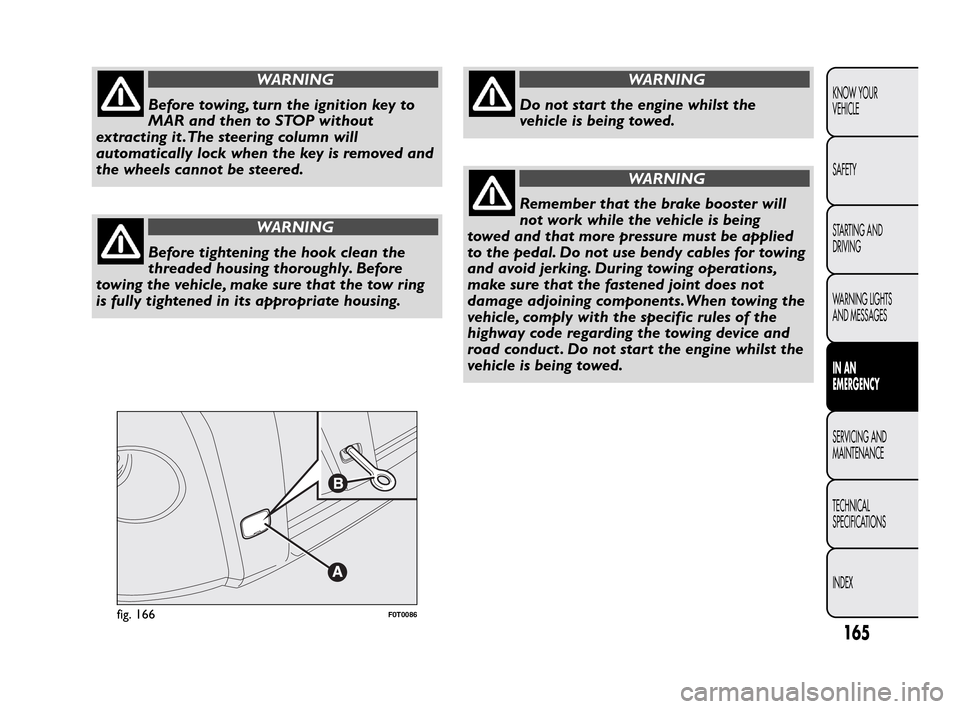
WARNING
Before towing, turn the ignition key to
M
ARandthentoSTOPwithout
extracting it .The steering column will
automatically lock when the key is removed and
the wheels cannot be steered.
WARNING
Before tightening the hook clean the
t
hreaded housing thoroughly. Before
towing the vehicle, make sure that the tow ring
is fully tightened in its appropriate housing.
WARNING
Do not start the engine whilst the
v
ehicle is being towed.
WARNING
Remember that the brake booster will
n
ot work while the vehicle is being
towed and that more pressure must be applied
to the pedal. Do not use bendy cables for towing
and avoid jerking. During towing operations,
make sure that the fastened joint does not
damage adjoining components.When towing the
vehicle, comply with the specific rules of the
highway code regarding the towing device and
road conduct . Do not start the engine whilst the
vehicle is being towed.
fig. 166F0T0086
165
KNOW YOUR
VEHICLE
SAFETY
STARTING AND
DRIVING
WARNING LIGHTS
AND MESSAGES
IN AN
EMERGENCY
SERVICING AND
MAINTENANCE
TECHNICAL
SPECIFICA
TIONS
INDEX
Page 174 of 230
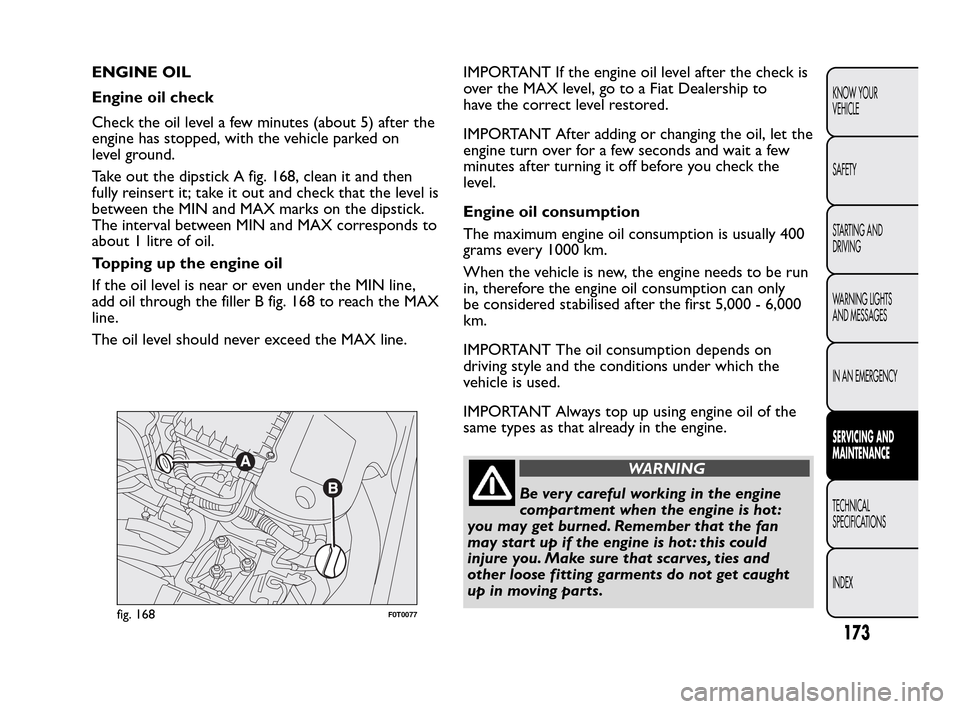
ENGINE OIL
Engine oil check
Check the oil level a few minutes (about 5) after the
engine has stopped, with the vehicle parked on
level ground.
Take out the dipstick A fig. 168, clean it and then
fully reinsert it; take it out and check that the level is
between the MIN and MAX marks on the dipstick.
The interval between MIN and MAX corresponds to
about 1 litre of oil.
Topping up the engine oil
If the oil level is near or even under the MIN line,
add oil through the filler B fig. 168 to reach the MAX
line.
The oil level should never exceed the MAX line.IMPORTANT If the engine oil level after the check is
over the MAX level, go to a Fiat Dealership to
have the correct level restored.
IMPORTANT After adding or changing the oil, let the
engine turn over for a few seconds and wait a few
minutes after turning it off before you check the
level.
Engine oil consumption
The maximum engine oil consumption is usually 400
grams every 1000 km.
When the vehicle is new, the engine needs to be run
in, therefore the engine oil consumption can only
be considered stabilised after the first 5,000 - 6,000
km.
IMPORTANT The oil consumption depends on
driving style and the conditions under which the
vehicle is used.
IMPORTANT Always top up using engine oil of the
same types as that already in the engine.
WARNING
Be very careful working in the engine
c
ompartment when the engine is hot :
you may get burned. Remember that the fan
may start up if the engine is hot : this could
injure you. Make sure that scarves, ties and
other loose fitting garments do not get caught
up in moving parts.
fig. 168F0T0077
173
KNOW YOUR
VEHICLE
SAFETY
STARTING AND
DRIVING
WARNING LIGHTS
AND MESSAGES
IN AN EMERGENCY
SERVICING AND
MAINTENANCE
TECHNICAL
SPECIFICA
TIONS
INDEX
Page 181 of 230
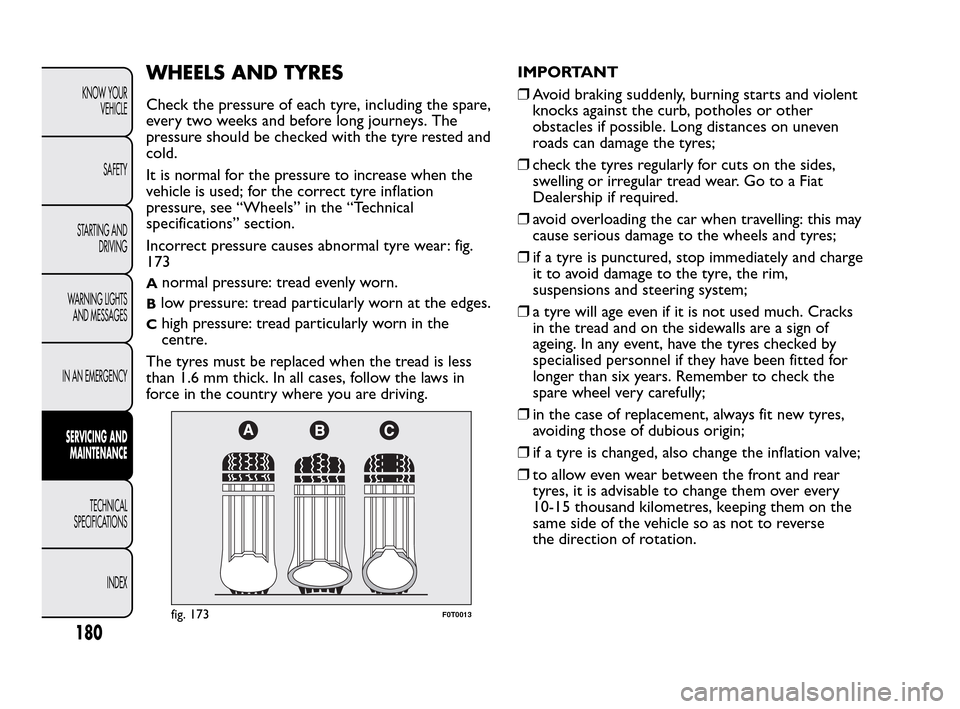
WHEELS AND TYRES
Check the pressure of each tyre, including the spare,
every two weeks and before long journeys. The
pressure should be checked with the tyre rested and
cold.
It is normal for the pressure to increase when the
vehicle is used; for the correct tyre inflation
pressure, see “Wheels” in the “Technical
specifications” section.
Incorrect pressure causes abnormal tyre wear: fig.
173
Anormal pressure: tread evenly worn.
Blow pressure: tread particularly worn at the edges.
Chigh pressure: tread particularly worn in the
centre.
The tyres must be replaced when the tread is less
than 1.6 mm thick. In all cases, follow the laws in
force in the country where you are driving.IMPORTANT
❒Avoid braking suddenly, burning starts and violent
knocks against the curb, potholes or other
obstacles if possible. Long distances on uneven
roads can damage the tyres;
❒check the tyres regularly for cuts on the sides,
swelling or irregular tread wear. Go to a Fiat
Dealership if required.
❒avoid overloading the car when travelling: this may
cause serious damage to the wheels and tyres;
❒if a tyre is punctured, stop immediately and charge
it to avoid damage to the tyre, the rim,
suspensions and steering system;
❒a tyre will age even if it is not used much. Cracks
in the tread and on the sidewalls are a sign of
ageing. In any event, have the tyres checked by
specialised personnel if they have been fitted for
longer than six years. Remember to check the
spare wheel very carefully;
❒in the case of replacement, always fit new tyres,
avoiding those of dubious origin;
❒if a tyre is changed, also change the inflation valve;
❒to allow even wear between the front and rear
tyres, it is advisable to change them over every
10-15 thousand kilometres, keeping them on the
same side of the vehicle so as not to reverse
the direction of rotation.
fig. 173F0T0013
180
KNOW YOUR
VEHICLE
SAFETY
STARTING AND
DRIVING
WARNING LIGHTS
AND MESSAGES
IN AN EMERGENCY
SERVICING AND
MAINTENANCE
TECHNICAL
SPECIFICA
TIONS
INDEX
Page 187 of 230
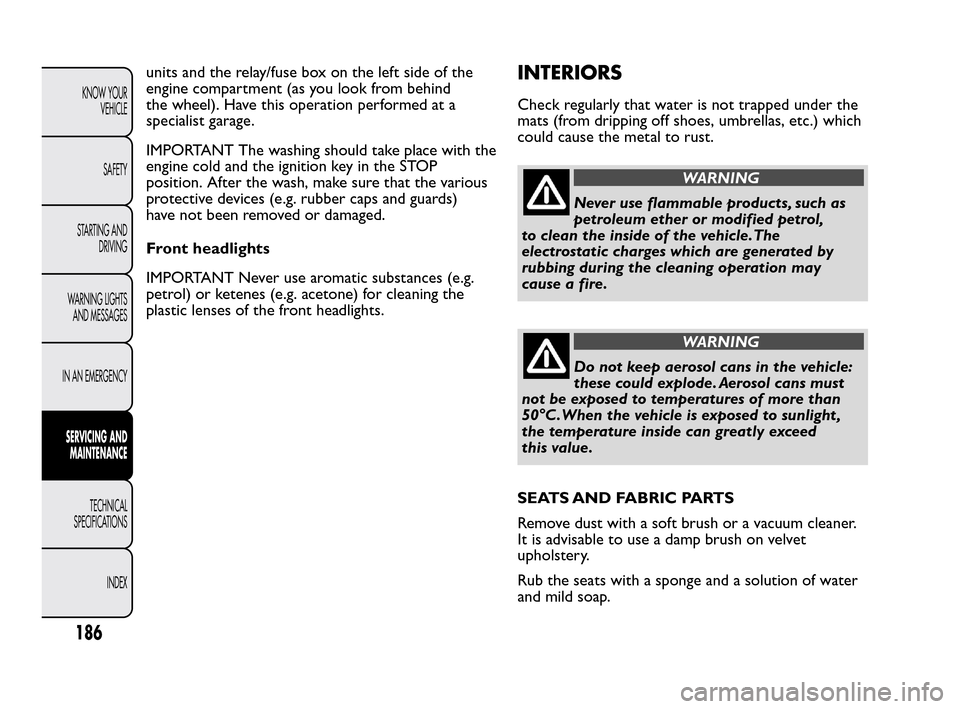
units and the relay/fuse box on the left side of the
engine compartment (as you look from behind
the wheel). Have this operation performed at a
specialist garage.
IMPORTANT The washing should take place with the
engine cold and the ignition key in the STOP
position. After the wash, make sure that the various
protective devices (e.g. rubber caps and guards)
have not been removed or damaged.
Front headlights
IMPORTANT Never use aromatic substances (e.g.
petrol) or ketenes (e.g. acetone) for cleaning the
plastic lenses of the front headlights.INTERIORS
Check regularly that water is not trapped under the
mats (from dripping off shoes, umbrellas, etc.) which
could cause the metal to rust.
WARNING
Never use flammable products, such as
pet
roleum ether or modified petrol,
to clean the inside of the vehicle.The
electrostatic charges which are generated by
rubbing during the cleaning operation may
cause a fire.
WARNING
Do not keep aerosol cans in the vehicle:
t
hese could explode. Aerosol cans must
not be exposed to temperatures of more than
50°C.When the vehicle is exposed to sunlight ,
the temperature inside can greatly exceed
this value.
SEATS AND FABRIC PARTS
Remove dust with a soft brush or a vacuum cleaner.
It is advisable to use a damp brush on velvet
upholstery.
Rub the seats with a sponge and a solution of water
and mild soap.
186
KNOW YOUR
VEHICLE
SAFETY
STARTING AND
DRIVING
WARNING LIGHTS
AND MESSAGES
IN AN EMERGENCY
SERVICING AND
MAINTENANCE
TECHNICAL
SPECIFICA
TIONS
INDEX
Page 227 of 230
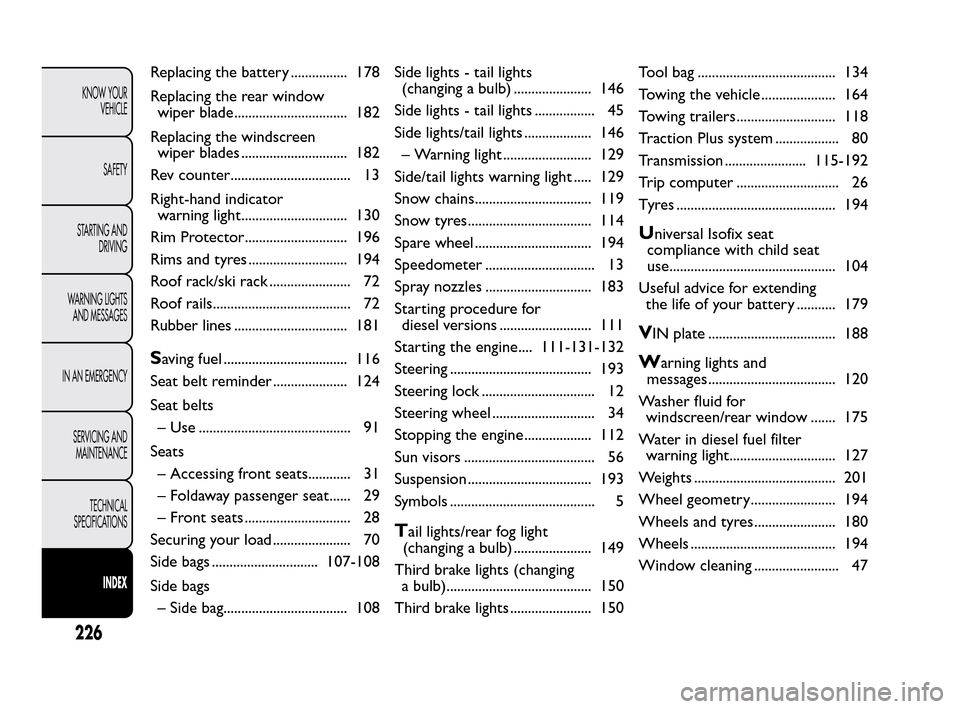
Replacing the battery ................ 178
Replacing the rear window
wiper blade................................ 182
Replacing the windscreen
wiper blades .............................. 182
Rev counter.................................. 13
Right-hand indicator
warning light.............................. 130
Rim Protector............................. 196
Rims and tyres ............................ 194
Roof rack/ski rack ....................... 72
Roof rails....................................... 72
Rubber lines ................................ 181
Saving fuel ................................... 116
Seat belt reminder ..................... 124
Seat belts
– Use ........................................... 91
Seats
– Accessing front seats............ 31
– Foldaway passenger seat...... 29
– Front seats .............................. 28
Securing your load ...................... 70
Side bags .............................. 107-108
Side bags
– Side bag................................... 108Side lights - tail lights
(changing a bulb) ...................... 146
Side lights - tail lights ................. 45
Side lights/tail lights ................... 146
– Warning light ......................... 129
Side/tail lights warning light ..... 129
Snow chains................................. 119
Snow tyres................................... 114
Spare wheel ................................. 194
Speedometer ............................... 13
Spray nozzles .............................. 183
Starting procedure for
diesel versions .......................... 111
Starting the engine.... 111-131-132
Steering ........................................ 193
Steering lock ................................ 12
Steering wheel ............................. 34
Stopping the engine ................... 112
Sun visors ..................................... 56
Suspension ................................... 193
Symbols ......................................... 5
Tail lights/rear fog light
(changing a bulb) ...................... 149
Third brake lights (changing
a bulb)......................................... 150
Third brake lights ....................... 150Tool bag ....................................... 134
Towing the vehicle ..................... 164
Towing trailers ............................ 118
Traction Plus system .................. 80
Transmission ....................... 115-192
Trip computer ............................. 26
Tyres ............................................. 194
Universal Isofix seat
compliance with child seat
use............................................... 104
Useful advice for extending
the life of your battery ........... 179
VIN plate .................................... 188
Warning lights and
messages .................................... 120
Washer fluid for
windscreen/rear window ....... 175
Water in diesel fuel filter
warning light.............................. 127
Weights ........................................ 201
Wheel geometry........................ 194
Wheels and tyres ....................... 180
Wheels ......................................... 194
Window cleaning ........................ 47
226
KNOW YOUR
VEHICLE
SAFETY
STARTING AND
DRIVING
WARNING LIGHTS
AND MESSAGES
IN AN EMERGENCY
SERVICING AND
MAINTENANCE
TECHNICAL
SPECIFICATIONS
INDEX